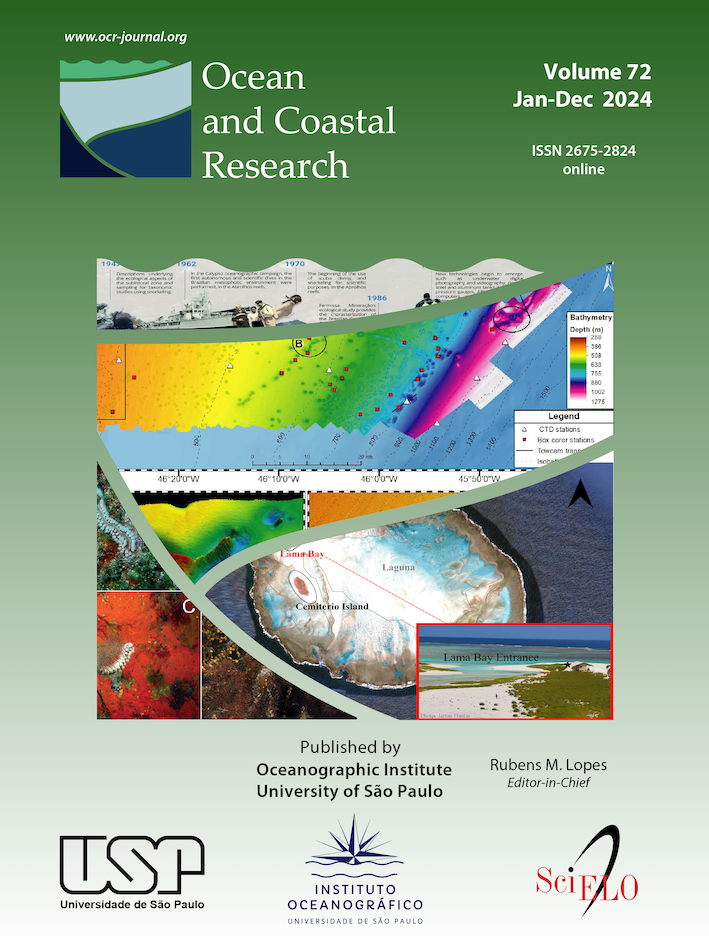Aggregative behavior of blackfin tuna (Thunnus atlanticus) following a fishing boat in the southwestern tropical Atlantic Ocean
DOI:
https://doi.org/10.1590/Keywords:
Tuna behavior, Associated schools, Fishing boats, FADsAbstract
The blackfin tuna (Thunnus atlanticus) is a small epipelagic species restricted to the western and central Atlantic
Ocean that has aggregative behavior, living in large schools usually associated with other tunas and commonly
caught near moored Fish Aggregating Devices (FAD) or natural floating objects. This work offers the first report
of a blackfin tuna school following a fishing boat serving as a drifting FAD in the southwestern tropical Atlantic
Ocean, which occurred during the tagging campaign for the Atlantic Ocean Tropical Tuna Tagging Program
(AOTTP) in May 2019. The blackfin tuna school followed the boat for approximately 190 nautical miles during
almost 60 hours. The school remained close to surface when the boat was in motion but moved to deeper
waters (60 m) in those few moments when the boat remained drifting. Along with the tagging activities, which
occurred mainly in the morning, we caught 17 blackfin tunas with size ranging from 46 to 58 cm fork length (FL)
(mean ± SD: 52.47 ± 3.35 cm FL) and weight ranged from 2.3 to 4.04 kg (3.2 ± 0.5 kg).
References
Collette, B. B. & Nauen, C. E. 1983. FAO Species catalogue.
Scombrids of the world: an annotated and illustrated
catalogue of tunas mackerels, bonitos and related
species known to date (vol. 2). Rome, FAO.
Dagorn, L., Josse, E., Bach, P. & Bertrand, A. 2000. Modeling
tuna behavior near floating objects: from individuals to
aggregations. Aquatic Living Resources, 13, 203–211.
DOI: https://doi.org/10.1016/S0990-7440(00)01065-2
Fenton, J., Ellis, J. M., Falterman, B. & Kerstetter, D. W.
Habitat utilization of blackfin tuna, Thunnus
atlanticus, in the north-central Gulf of Mexico.
Environmental Biology of Fishes, 98, 1141–1150. DOI:
https://doi.org/10.1007/s10641-014-0347-3
Fontaneau, A. & Diouf, T. 1994. An efficient way of bait-fi
shing for tunas recently developed in Senegal. Aquatic
Living Resources, 7(3), 139–151. DOI: https://doi.
org/10.1051/alr:1994017
Freire, K. M. F., Lessa, R. & Lins-Oliveira, J. E. 2005.
Fishery and biology of blackfin tuna Thunnus
atlanticus off Northeastern Brazil. Gulf and Caribbean
Research, 17(1), 15–24. DOI: https://doi.org/10.18785/
gcr.1701.02
Hallier, J. P. & Molina, A. D. 2000. Bait boat as a tuna
aggregating device. Le canneur: un dispositif de
concentration des thons, Edition Ifremer. In: Le Gall,
J.-Y., Cayré, P. & Taquet, M. (eds.). Pêches thonières
et dispositifs de concentration de poissons (28 ed.;
pp. 553-578). Strasbourg: Actes Colloques.
Taquet, M., Reynal, L., Laurans, M. & Lagin, A. 2000.
Blackfin tuna (Thunnus atlanticus) fishing around FADs
in Martinique (French West Indies). Aquatic Living
Resources, 13, 259−262. DOI: https://doi.org/10.1016/
S0990-7440(00)01056-1
Schroeder, F. A. & Castello, J. P. 2007. “Cardume
associado”: nova modalidade de pesca de atuns no
Sul do Brasil – descrição e comparação. Pan-American
Journal of Aquatic Sciences, 2(1), 66–74.
Silva, G. B., Hazin, H. G. & Araújo, P. V. N. 2018. Fishing
methods to catch tunas on aggregated schools at
the vicinity of a data buoy in the western Equatorial
Atlantic. Brazilian Journal of Oceanography, 66(4),
–338. DOI: http://dx.doi.org/10.1590/S1679-
Downloads
Published
Issue
Section
License
Ocean and Coastal Research is an open-access journal available through SciELO (Scientific Electronic Library Online).
Ocean and Coastal Research journal title abbreviation is Ocean Coast. Res. and should be used in footnotes, references, and bibliographic entries.
All Ocean and Coastal Research scientific articles are freely available without charge to the user or institution. In accordance with the BOAI definition of open access, all contents are available to readers free of charge. Users may read, download, copy, and link to the full texts of the articles. They may be used for any lawful purpose without prior authorization from the publisher or the author, as long as proper credit is given to the original publication.
All Ocean and Coastal Research published scientific articles receive an individual Digital Object Identifier (DOI) persistent digital document identification.
All the content of the journal, except where otherwise noted, is licensed under a Creative Commons License type BY. Authors retain the copyright and full publishing rights without restrictions.
More information on intellectual property can be found here and on Scielo's Open Acess Statement.
Ocean and Coastal Research is listed in Publons and reviewers and editors can add their verified peer review and editing history to their Publons profile.
Ocean and Coastal Research is indexed in the Directory of Open Access Journals (DOAJ) and complies with principles of transparency and best practice for scholarly publications.
Ocean and Coastal Research is committed to the best standards in open-access publishing by adopting ethical and quality standards throughout the publishing process - from initial manuscript submission to the final article publication. This ensures authors that their work will have visibility, accessibility, reputation, usage, and impact in a sustainable model of scholarly publishing.




